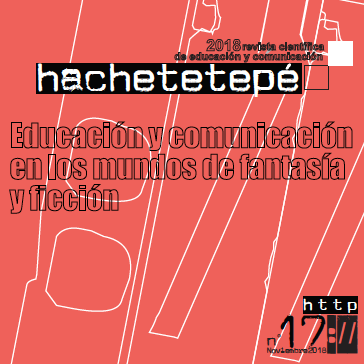Not so much, not even…
Abstract
In the journey towards an inclusive education, we find superpositions, contradictions and uncertainties. The emerging pedagogies and technological tools that flood the educational field require responsible decision-making at the three levels of concretion (governmental, institutional and academic). It is time to recover the teaching prestige and position from the professional exercise the balanced and pertinent use of ICTs, tending to a fair measure between excess and defect, invoking rationality, thinking about effects and consequences, noting that they are tools that do not replace a good teaching.
Keywords
Downloads
How to Cite
License

This work is licensed under a Creative Commons Attribution-NonCommercial-NoDerivatives 4.0 International License.
Those authors who have published with this journal, accept the following terms:
- They will retain their copyright and guarantee the journal the right to first publication of their work, which will simultaneously be subject to the Creative Commons Attribution License . They may be copied, used, disseminated, transmitted and publicly displayed, provided that the authorship, url, and magazine are cited, and are not used for commercial purposes. No derivative works are allowed.
- They may adopt other non-exclusive license agreements for the distribution of the published version of the work (e.g., deposit it in an institutional telematic archive or publish it in a monographic volume) provided that the initial publication in this journal is indicated.
- Disseminate your work through the Internet (e.g., in institutional telematic archives or on your website) once the manuscript is accepted, which may lead to interesting exchanges and increased citations of the published work. (See The effect of open access).
Hachetetepé. Scientific journal of education and communication does not charge a fee for the submission of manuscripts or for the publication of its articles.
References
Bayse, D. (24 de enero de 2018). ISTE. Recuperado el 5 de mayo de 2018, de Aprendizaje personalizado vs. diferenciado vs. individualizado. Disponible en: https://www.iste.org/explore/articleDetail?articleid=124
Bilagher, M. (2017). OREALC | UNESCO Santiago. Obtenido de ¿Qué podemos aprender de las evaluaciones educativas a gran escala? Disponible en: http://www.unesco.org/new/es/santiago/press-room/newsletters/newsletter-laboratory-for-assessment-of-the-quality-of-education-llece/n17/03/
CAST. (2018). Center for Applied Special Technology. Recuperado el 15 de mayo de 2018, Disponible en: http://www.cast.org/
Comité CDPD. (2016). OHCHR. Obtenido de Comité sobre los Derechos de las Personas con Discapacidad (CDPD). Disponible en: https://www.ohchr.org/EN/HRBodies/CRPD/Pages/CRPDIndex.aspx
Elacqua, G., Hincapié, D., Vegas, E., Alfonso, M., Montalva, V., & Paredes, D. (2018). Profesión: profesor en América Latina. ¿Por qué se perdió el prestigio docente y cómo recuperarlo? Washington D.C.: Banco Interamericano de Desarrollo -BID. Disponible en:doi:http://dx.doi.org/10.18235/0001172#sthash.aJXPmv3J.dpuf
Emerich, F. (2 de julio de 2018). EdSurge. Recuperado el 5 de julio de 2018, de ¿Por qué todavía estamos personalizando el aprendizaje si no es personal? Disponible en: https://www.edsurge.com/news/2018-07-02-why-are-we-still-personalizing-learning-if-it-s-not-personal
Enkvist, I. (2014). Educación. Guía para perplejos. Madrid: Ediciones Encuentro.
Fuerte, K., & Guijosa, C. (9 de julio de 2018). Observatorio de Innovación Educativa. Recuperado el 9 de julio de 2018, de Tecnológico de Monterrey. Disponible en: https://observatorio.itesm.mx/edu-news/glosario-de-innovacion-educativa
García, J. (20 de abril de 2016). Ined21. Recuperado el 25 de julio de 2017, de La personalización del aprendizaje: individualizar vs personalizar. Disponible en: https://ined21.com/personalizacion-del-aprendizaje-individualizar-vs-personalizar/
García, M., Gallego, C., & Cotrina, M. (marzo de 2014). Movilizando sistemas de apoyo inclusivos a través de
Grupos de Apoyo Mutuo. Educación Inclusiva | Inclusive Education Journal, 7(1), 46-62. Disponible en: http://www.revistaeducacioninclusiva.es/index.php/REI/article/view/162
Hattie, J. (2017). Aprendizaje visible para profesores. Maximizando el impacto en el aprendizaje. (C. Ors, Trad.) Madrid: Ediciones Paraninfo S.A.
Hattie, J. (julio de 2018). Visible-learning.org. Obtenido de Hattie classification. Interactive. Disponible en: https://visible-learning.org/nvd3/visualize/hattie-ranking-interactive-2009-2011-2015.html
Ministerio de Educación, Cultura y Deporte. (2012). ITE. (I. N. Profesorado, Editor) Recuperado el 18 de diciembre de 2016, de Educación Inclusiva. Iguales en la diversidad. Disponible en: http://www.ite.educacion.es/formacion/materiales/126/cd/pdf/m6_ei.pdf
Muntaner, J. (2014). Quadern digitals. Palma de Mallorca. Obtenido de Los apoyos facilitadores para la inclusión. Disponible en: http://www.quadernsdigitals.net/datos/hemeroteca/r_77/nr_845/a_11342/11342.pdf
OEA | SEDI. (2016). Segundo Informe de Cumplimiento de los Estados Parte de la Convención. Disponible en: https://www.oas.org/es/sedi/ddse/paginas/txt_discapacidad_segundoinforme.html
Parrilla, Á. (15 de enero de 2002). Acerca del origen y sentido de la educación inclusiva. Revista de Educación(327), 11-29. Disponible en: https://www.mecd.gob.es/dctm/revista-de-educacion/articulos327/re3270210520.pdf?documentId=0901e72b81259a76
Pastor, C., Sánchez, J., & Zubillaga del Río, A. (23 de noviembre de 2014). educaDUA. Recuperado el 8 de mayo de 2018, de Diseño Universal para el Aprendizaje (DUA). Pautas para su introducción en el currículo. Disponible en : http://www.educadua.es/doc/dua/dua_pautas_intro_cv.pdf
Rose, D., & Meyer, A. (2002). Teaching every student in the digital age: Universal Design for Learning. Alexandria: Association for Supervision and Curriculum Development.
UDL. (30 de september de 2011). UDL. Obtenido de Universal Design for Learning Guidelines - Version 1.0. Disponible en: https://udlguidelines.wordpress.com/
UNESCO. (junio de 2017). Herramientas de Formación para el Desarrollo Curricular. (O. I. Educación, & UNESCO, Edits.) Ginebra: OIE-UNESCO. Obtenido de Aprendizaje Personalizado. Disponible en: http://unesdoc.unesco.org/images/0025/002500/250057s.pdf
UNICEF. (2013). Niños, niñas y jóvenes con discapacidad. Hoja informativa. Obtenido de Unicef.org. Disponible en: https://www.unicef.org/disabilities/files/Factsheet_A5-o_spanish-r4.pdf
Visible Learningplus. (2017). Obtenido de 250+ Influences on Student Achievement. Disponible en: https://visible-learning.org/wp-content/uploads/2018/03/VLPLUS-252-Influences-Hattie-ranking-DEC-2017.pdf
Zabalza, M. Á. (2009). Apoyo a la escuela y procesos de diversidad educativa. En Á. Parrilla, Apoyo a la escuela: un proceso de colaboración. Buenos Aires: Mensajero.






